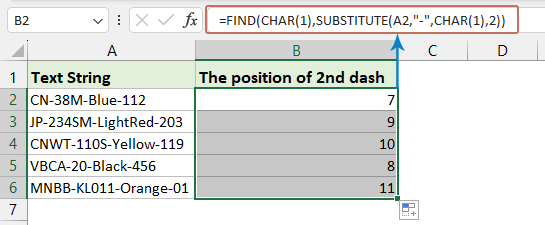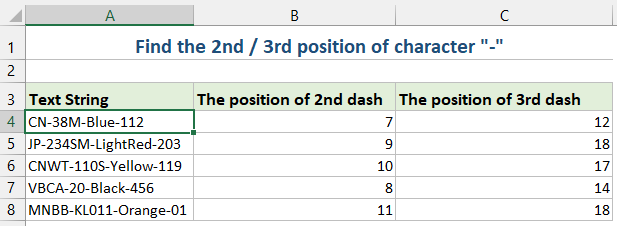在 Excel 中查找字元的第 n 次出現位置 – 3 種快速方法
在 Excel 的文字字串中尋找特定字元的第 n 次出現位置,在資料分析中特別有用,您可能需要根據某些分隔符號或模式來解析字串或提取資訊。例如,讓我們在文字字串中找到字元 "-" 的第 2 次或第 3 次出現位置。我將展示一些直接的方法來高效完成此任務。
使用公式查找文字字串中的第 n 次字元出現位置
您可以設計一個公式來查找字元的第 n 次出現位置。請按照以下步驟操作:
1. 在您想要獲取結果的單元格中輸入或複製以下公式:
=FIND(CHAR(1),SUBSTITUTE(A2,"-",CHAR(1),2))- "A2": 包含字串的單元格。
- "-": 您要查找的字元。
- "2": 您要查找的第 2 次出現位置,您可以根據需要更改為 3、4…等。
2. 然後,拖動公式填充柄以將公式填充到其他單元格,並立即顯示字元 "-" 的第 2 次出現位置,請參閱截圖:
- "SUBSTITUTE" 將字元的第 n 次出現位置替換為不可列印的字元(CHAR(1))。
- "FIND" 搜尋這個不可列印的字元,給出第 n 次出現的位置。
使用 Kutools for Excel 查找文字字串中的第 n 次字元出現位置
如果您不喜歡使用公式或 VBA,可以考慮一個方便的替代方案 – "Kutools for Excel"。在其公式群組中,您會找到一個有用的工具 – "查找字符在字串中第 N 次出現的位置",該工具能快速識別並返回單元格中任何字元的第 n 次出現位置。
安裝 Kutools for Excel 後,點擊 "Kutools" > "公式助手" > "公式助手" 以打開 "公式助手" 對話框。點擊您想放置結果的單元格。然後,按照以下步驟操作:
- 從 "公式類型" 區域的下拉列表中選擇 "查找";
- 在 "選擇一個公式" 區域中選擇 "查找字符在字串中第 N 次出現的位置";
- 選擇包含您使用的字串的單元格,然後在 "參數輸入" 區域的文本框中輸入指定的字元和第 n 次出現位置;
- 最後,點擊 "確定" 按鈕以獲得結果。

Kutools for Excel - 超過 300 種必備工具,讓 Excel 功能更強大。永久免費享受 AI 功能!立即獲取
使用使用者定義函數 (UDF) 查找文字字串中的第 n 次字元出現位置
在本節中,我們將探討如何創建和使用 UDF 來查找 Excel 中字元的第 n 次出現位置,提供逐步指南以幫助您優化數據處理。
- 按住 "ALT" + "F11" 鍵,打開 "Microsoft Visual Basic for Applications" 視窗。
- 點擊 "插入" > "模組",並將以下宏粘貼到模組視窗中。
Function FindN(sFindWhat As String, _ sInputString As String, N As Integer) As Integer 'Updateby Extendoffice Dim J As Integer Application.Volatile FindN = 0 For J = 1 To N FindN = InStr(FindN + 1, sInputString, sFindWhat) If FindN = 0 Then Exit For Next End Function - 然後,關閉 vba 視窗。返回工作表,在單元格中輸入以下公式,然後拖動填充柄向下填充公式到其他單元格,請參閱截圖:
=FindN("-",A2,3)
- 計算一列中某個單詞的出現次數
- 如果您有一列數據,其中包含一些重複值,如下方截圖所示,現在您想做的是計算該列中某個特定單詞的出現次數。現在通過本教程,我將介紹一些技巧來快速解決它。
- 替換前 n 個字元或第 n 次出現的字元為另一個
- 在 Excel 中,我們通常使用尋找和替換功能來查找和替換字串,但如果您處於以下情況之一,尋找和替換功能無法幫助您。
- 從字串中提取第 n 個字元
- 一般來說,您可能希望在特定字元之後提取字串,但在這種情況下,我想從字串中提取第 n 個字元,如下方截圖所示。
- 從字串中提取前/後 n 個字元
- 例如,有一個列表,每個單元格中都有很長的字串,而您只想從每個字串中提取前 n 個字元,比如每個字串的前 3 個字元,現在您可以使用以下方法在 Excel 中解決它。
相關文章:
最佳 Office 生產力工具
| 🤖 | Kutools AI 助手:以智能執行為基礎,革新數據分析 |生成程式碼 | 創建自訂公式 | 分析數據並生成圖表 | 調用 Kutools 增強函數… |
| 熱門功能:查找、選取項目的背景色或標記重複值 | 刪除空行 | 合併列或單元格且不遺失數據 | 四捨五入(免公式)... | |
| 高級 LOOKUP:多條件 VLookup|多值 VLookup|多表查找|模糊查找... | |
| 高級下拉列表:快速創建下拉列表 |依賴型下拉列表 | 多選下拉列表... | |
| 列管理器:添加指定數量的列 | 移動列 | 切換隱藏列的顯示狀態 | 比較區域及列... | |
| 精選功能:網格聚焦 | 設計檢視 | 增強編輯欄 | 工作簿及工作表管理器 | 資源庫(快捷文本) | 日期提取器 | 合併資料 | 加密/解密儲存格 | 按列表發送電子郵件 | 超級篩選 | 特殊篩選(篩選粗體/傾斜/刪除線...)... | |
| 15 大工具集:12 項文本工具(添加文本、刪除特定字符…)|50+ 儀表 類型(甘特圖等)|40+ 實用 公式(基於生日計算年齡等)|19 項插入工具(插入QR码、根據路徑插入圖片等)|12 項轉換工具(金額轉大寫、匯率轉換等)|7 項合併與分割工具(高級合併行、分割儲存格等)|...及更多 |
運用 Kutools for Excel,全面提升您的 Excel 技能,體驗前所未有的高效。 Kutools for Excel 提供超過300 項進階功能,讓您提升工作效率、節省時間。 點此尋找您最需要的功能...
Office Tab 為 Office 帶來分頁介面,讓您的工作更加輕鬆簡單
- 在 Word、Excel、PowerPoint 中啟用分頁編輯與閱讀。
- 在同一視窗的新分頁中打開與創建多份文件,而非開啟新視窗。
- 提升您的生產力50%,每日可幫您減少數百次鼠標點擊!
所有 Kutools 外掛,一次安裝
Kutools for Office 套裝整合了 Excel、Word、Outlook 和 PowerPoint 的外掛,外加 Office Tab Pro,非常適合需要跨 Office 應用程式協同作業的團隊。
- 全合一套裝 — Excel、Word、Outlook及 PowerPoint 外掛 + Office Tab Pro
- 一鍵安裝,一份授權 — 幾分鐘完成設置(支援 MSI)
- 協同運作更順暢 — Office 應用間無縫提升生產力
- 30 天全功能試用 — 無需註冊、無需信用卡
- 最超值 — 一次購買,節省單獨外掛費用


